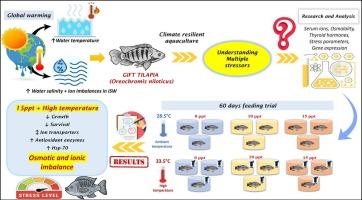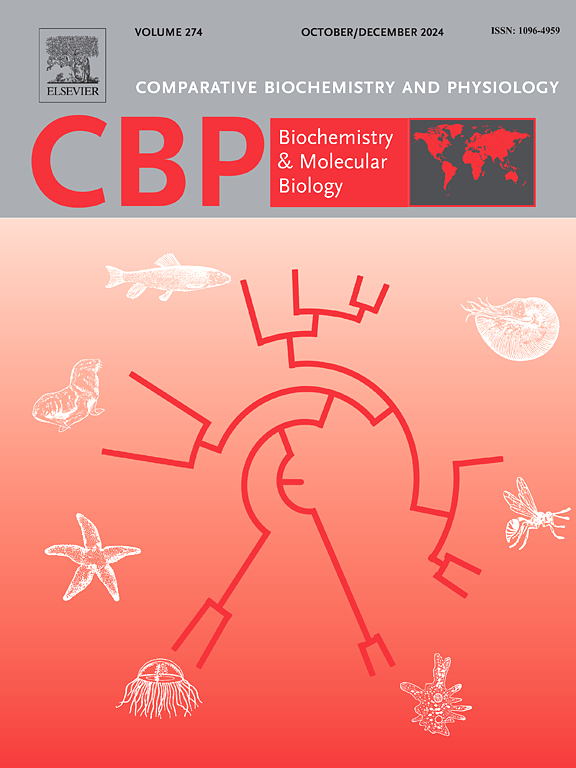高温和盐度胁迫对内陆咸水养殖转基因罗非鱼的综合生理影响。
IF 1.8
3区 生物学
Q4 BIOCHEMISTRY & MOLECULAR BIOLOGY
Comparative Biochemistry and Physiology B-Biochemistry & Molecular Biology
Pub Date : 2025-10-03
DOI:10.1016/j.cbpb.2025.111165
引用次数: 0
摘要
淡水短缺和内陆水体日益盐碱化对水产养殖构成重大挑战。利用内陆咸水(ISW)进行水产养殖为将农业扩展到受盐影响和非耕地地区提供了一个有希望的选择。通过60 d的试验,研究了温度和不同盐度对吉富罗非鱼(GIFT)鱼种(初始体重2.73±0.02 g)的综合影响。鱼被随机分布在6个处理中,放置在3个重复的鱼缸中(n=15/鱼缸)。实验包括两种温度(常温28.5±0.39°C, AT;高温33.5±0.17°C, HT)和三种盐度(淡水0-2.25 ppt; ISW 10 ppt; ISW 15 ppt)的组合。分析了生长参数、存活率、渗透调节参数和胁迫标志物。温度和盐度交互作用显著,htx15组生长和成活率最差。血清渗透压和离子(Na+、Ca2+和Cl-)随盐度逐渐升高,在高温下进一步升高,而K+呈相反趋势。鳃离子转运体如钠钾atp酶、nka1α、氯离子通道clc2 mRNA的表达随盐度升高而升高,而水通道蛋白aqp1的表达则下调。血清应激标志物(皮质醇和葡萄糖)随两种应激源呈剂量依赖性增加。血清甲状腺激素下降,在htx15时达到最低水平。抗氧化酶表现出组织特异性反应:在htx15时,肝脏抗氧化酶增加了3- 4倍,而鳃酶则出现中度升高。htx15组肝脏hsp70基因表达上调3倍。这些发现有助于确定环境限制,以支持鱼类健康,生长和可持续性在内陆盐水水产养殖在热和盐胁迫下。本文章由计算机程序翻译,如有差异,请以英文原文为准。

Combined physiological effects of high temperature and salinity stress on genetically improved farmed tilapia (Oreochromis niloticus) reared in inland saline water
Freshwater scarcity and increasing salinisation of inland water bodies pose significant challenges to agriculture and traditional freshwater aquaculture. Using inland saline water (ISW) for aquaculture offers a promising option to expand farming into salt-affected and non-arable regions. An experimental trial (60 days) was conducted to evaluate the combined effect of temperature and ISW of varying salinities on genetically improved farmed tilapia (GIFT) fingerlings (initial weight: 2.73 ± 0.02 g). Fish were distributed randomly across 6 treatments in triplicate tanks (n=15/tank). The experiment included combinations of two temperatures (Ambient: 28.5 ± 0.39 °C, AT; High: 33.5 ± 0.17 °C, HT) and three salinities (Freshwater, 0-2.25 ppt; ISW, 10 ppt; ISW, 15 ppt). Growth parameters, survival, osmoregulatory parameters and stress markers were analysed. The temperature and salinity interaction was significant, with the poorest growth and survival in the HT X 15 group. Serum osmolality and ions (Na+, Ca2+ and Cl-) increased progressively with salinity, and were further elevated at HT, while K+ showed the opposite trend. mRNA expression of branchial ion transporters such as sodium potassium ATPase, nka1α, and chloride channel, clc2, showed an increase with salinity, while aquaporin, aqp1, was downregulated. Serum stress markers (cortisol and glucose) increased dose-dependently with both stressors. Serum thyroid hormones declined, reaching minimum levels at HT X 15. Antioxidant enzymes showed tissue-specific responses: liver antioxidant enzymes increased 3- 4 fold at HT X 15, while gill enzymes showed moderate elevation. Hepatic hsp70 gene expression was upregulated (3-fold) in the HT X 15 group. These findings help define environmental limits to support fish health, growth, and sustainability in inland saline aquaculture under thermal and salinity stress.
求助全文
通过发布文献求助,成功后即可免费获取论文全文。
去求助
来源期刊
CiteScore
4.60
自引率
4.50%
发文量
77
审稿时长
22 days
期刊介绍:
Comparative Biochemistry & Physiology (CBP) publishes papers in comparative, environmental and evolutionary physiology.
Part B: Biochemical and Molecular Biology (CBPB), focuses on biochemical physiology, primarily bioenergetics/energy metabolism, cell biology, cellular stress responses, enzymology, intermediary metabolism, macromolecular structure and function, gene regulation, evolutionary genetics. Most studies focus on biochemical or molecular analyses that have clear ramifications for physiological processes.

 求助内容:
求助内容: 应助结果提醒方式:
应助结果提醒方式:


